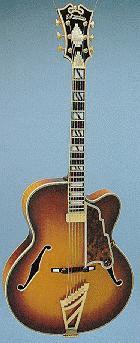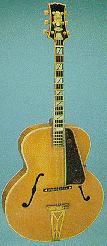Vintage Guitars Info's
Other Vintage Guitar Makers:
Kay, D'Angelico, Stromberg, Hofner.
D'angelico, Stromberg, Kay, Hofner vintage guitars history and collecting. Private vintage guitar collector. Pictures, history for other makes of vintage guitars.
Contact the Vintage Guitar Info Guy.
1958 Kay Barney Kessel Pro
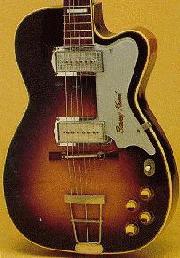
- Kay guitars
- Hofner archtop guitars
- D'Angelico guitars
- Stromberg guitars
- Picture Gallery, Other makers
There are lots of other cool makes of instruments out there. But these are the "big" ones that I have some information on. Note the Hofner section has been greatly updated and moved to its own section, and removed from here.
Model Information for:
Back to the Table of Contents
Kay.
-
Kay primarily manufactured "department store" style, inexpensive guitars
from the 1930's to the 1960's. But they also made some hi-end, quality
archtop guitars. The most collectable Kays are any model with the "Kelvinator"
plastic headstock overlay with art deco patterns. Used from 1957 to 1960,
this headstock was named after the brand of refrigerator that looked quite similar.
This overlay was injection molded with clear acrylic plastic and then
back-painted either white or black, with gold highlights in the crest
and gold dots outside of the crest. Starting in late 1960, Kay switched to
a less expensive "half" Kelvinator that used just the triangle Kay crest
from the full Kelvinator, screwed to a simple black plastic headstock
veneer. This "half" Kelvinator dropped the black or white back-painted
acyrlic "lunchcountertop" surround with gold dots. This design only lasted
till the end of 1961 when the Kelvinator headstock was completely dropped.
1957-1960 Kay full
"Kelvinator" Headstock
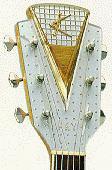
-
Note that Kay also made guitar with other brand names on the
headstock. These are still Kay's, just they are made for department store
type companies. This includes Spiegel ("Old Kraftsmen"), Montgomery Ward
("Sherwood Deluxe"), Sears and Roebuck ("Silvertone"), and Orpheum
through the 1950's and 1960's. The most common name (other than "Kay") is
by far "Old Kraftsmen".
Kays are notorious for having bad neck sets and broken truss rod systems. Usually, this can be corrected by a good repair person for around $150 to $200.
1959 Kay ad.

- Barney Kessel Pro.
-
Single cutaway archtop, 13" wide, veneer maple body, spruce top, no F-holes, 1 or 2 single
coil "Gold K" pickups, block fingerboard inlays starting at the 3rd fret,
"Kelvinator" peghead, "Barney Kessel" signature on the silver colored
acrylic pickguard, chrome open back Grover tuners, rosewood bridge,
sunburst or blond finish. Available 1957 to 1961. In 1960, Barney Kessel's signature
was removed from the pickguard.
- Barney Kessel Artist.
-
Single cutaway archtop, 15 1/2" wide, veneer maple body, spruce top, bound F-holes, 1 or 2
single coil "Gold K" pickups, block fingerboard inlays starting at the 1st
fret, rosewood fingerboard, "Barney Kessel" signature on the silver colored
acrylic pickguard, "Kelvinator" peghead, chrome Melita bridge, nickel Grover
tuners, sunburst or blond finish. Available 1957 to 1961. In 1960, Barney Kessel's signature
was removed from the pickguard.
- Barney Kessel Jazz Special.
-
Completed with the Gibson L-5CES. Single cutaway archtop, 17" wide, veneer maple body, spruce top, bound F-holes, 1 or 2 single
coil "Gold K" pickups, split-block fingerboard inlays, ebony fingerboard,
"Barney Kessel" signature on the silver colored acrylic pickguard, "Kelvinator"
peghead, chrome Melita bridge, chrome Grover Imperial tuners, sunburst or
blond finish. Available 1957 to 1961. In 1960, Barney Kessel's signature
was removed from the pickguard.
- The Upbeat.
-
Kay's less expensive alternative to the Barney Kessel Jazz Special. Single
cutaway archtop, 17" wide, veneer maple body, rosewood fingerboard with
pearloid block inlays starting at the 3rd fret, rosewood bridge, closed
back individual Kluson tuners with metal buttons, large scalloped pickguard
sometimes with silver sparkle, sunburst, blond or black
finish. Available with 1 or 2 "Gold K" single coil pickup from 1957 to 1959.
In late 1959, 3 pickup "ES-5" type model available. Made from 1957 to 1961.
Full Kelvinator headstock from 1957 to 1960, half Kelvinator headstock in
1961.
- K-161 ThinTwin (Jimmy Reed or Howlin' Wolf model).
-
15" wide, single cutaway, flat top semi-hollow maple body, blond top and
sunburst back and sides, 1 or 2 blade pickups, block fingerboard inlays
starting at the 3rd fret, rosewood fingerboard, trapeze tailpiece,
rosewood bridge fixed to top. Available 1952 to 1960. Tortoise shell
pickguard from 1952 to 1957, black pickguard from 1958 to 1960.
pre-1958 K-161
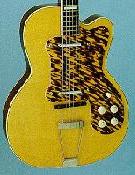
- Jazz II.
-
15 1/4" wide, double cutaway fully hollow 2" thick veneer maple body (like
an ES-330), rosewood fingerboard with "shark fin" inlays starting at the
3rd fret, two "Gold K" single coil pickups, bolt-on maple neck, Bigsby
vibrato and aluminum bridge, silver painted scalloped acrylic pickguard,
half Kelvinator headstock, nickel Grover tuners, bound top, back and
fingerboard, blond or sunburst finish. Available 1961 to ?.
- K-11 acoustic archtop.
-
Completed with the Gibson L-7C, Single custaway acoustic archtop, 17" wide veneer maple body, spruce top,
rosewood fingerboard, block or "shark fin" fingerboard inlays starting at
the 3rd fret, large scalloped pickguard, closed back individual Kluson
tuners with metal buttons, trapeze tailpiece, blond or
sunburst finish. Available 1953 to 1959. Starting in 1958 came with a full
Kelvinator headstock.
- K-21 acoustic archtop.
-
Completed with the Gibson L-5C. Single cutaway acoustic archtop, 17" wide, veneer maple body, spruce top,
ebony fingerboard, split-block fingerboard inlays, scalloped fingerboard
extension, ebony bridge, Kluson sealfast tuners, ES-300 style trapeze
tailpiece, large scalloped pickguard, blond or sunburst finish.
Available 1953 to 1959. Starting in 1958 came with full Kelvinator headstock.
1961 Kay Jazz II with semi-Kelvinator

- K-27 Flattop.
-
Same size as a Gibson J-200. 17" wide veneer maple body, spruce top with
X-bracing, ebony
fingerboard, pearl block inlays starting at the 1st fret, small screwed-on
pickguard, belly bridge. Available 1952 to 1963. Starting in 1958 came with
a full Kelvinator headstock. By 1961, a half Kalventor headstock was used.
- K-23 Flattop.
-
Same size as a Gibson J-200. 17" wide veneer maple body, spruce top with
X-bracing, rosewood
fingerboard, pearloid block inlays starting at the 3rd fret, small screwed-on
pickguard, rectangle bridge. Available 1952 to 1963. Starting in 1958 came with
a full Kelvinator headstock. By 1961, a half Kalventor headstock was used.
- K-22 Flattop.
-
Same size as a Gibson J-200. 17" wide mahogany body, spruce top with ladder
bracing, rosewood
fingerboard, pearloid block inlays starting at the 3rd fret, small screwed-on
pickguard, rectangle bridge. Available 1952 to 1963. Fingerboard inlays
changed to "double parallelagrams" in 1955.
- Kay Professional Cutaway Flattop.
-
Same size as a Gibson J-200. 17" wide veneer maple body with cutaway,
spruce top with X-bracing, rosewood fingerboard, pearloid block inlays
starting at the 3rd fret, small screwed-on
pickguard, belly bridge. Available 1955 to 1959.
Back to the Table of Contents
Harmony Guitars.
I do *not* collect Harmony guitars, and frankly don't know a lot about them. But I get constant questions on them. This is all I know, so please do not email me with any Harmony questions.Harmony was THE department store guitar until the early 1970s for cheap flat top and arch top guitars. Usually the stores would re-brand the guitar to their store guitar name (like Silvertone or Catalina, etc.) But I am constantly asked when they are made. Inside there are usually some ink-stamped numbers, as seen in the picture below. In this picture, the dark numbers (0129H929) represent the Harmony guitar model. In this case model Harmony ("H") H929. The light blue number (f-70) represents Fall 1970, which was when this guitar was made. Harmony used this type of markings from the 1950s to the 1970s.
Internal Harmony marking for model H929
made in the Fall of 1970 (F-70).
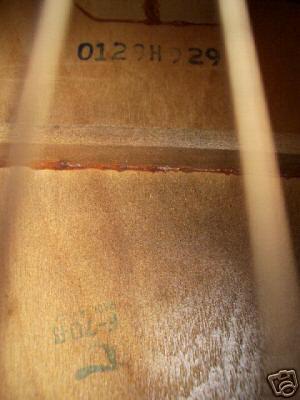
1959 Hofner Committee
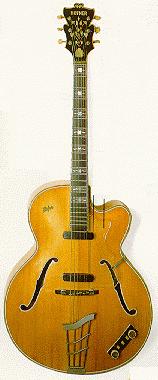
Hofner Archtop Guitars.
-
See the new and updated Hofner section by clicking
here.
Back to the Table of Contents
D'Angelico.
-
Players and collectors consider D'Angelico Excel and New Yorker models to
be amoung the finest archtop guitars ever made. They are extremely
collectable. Note that John D'Angelico died in 1964, and his apprentice
D'Aquisto finished his last few models that were "work in progress".
Serial Numbers 1932 to 1964.
-
D'Angelico serial numbers are not strictly chronological. Some overlaps
in date ranges occur.
Number range Year no number 1932-1934 1005 to 1097 1932-1934 1105 to 1235 1936 1234 to 1317 1937 1318 to 1385 1938 1388 to 1456 1939 1457 to 1508 1940 1509 to 1562 1941 1563 to 1621 1942 1622 to 1658 1943 1659 to 1681 1944 1682 to 1702 1945 1703 to 1740 1946 1738 to 1781 1947 1782 to 1804 1948 1805 to 1831 1949 1832 to 1855 1950 1856 to 1885 1951 1886 to 1908 1952 1909 to 1936 1953 1933 to 1962 1954 1961 to 1988 1955 1989 to 2017 1956 2018 to 2040 1957 2041 to 2067 1958 2068 to 2098 1959 2099 to 2122 1960 2123 to 2164 1961-1964 2211 to 2214 1955-1956
- Style A:
-
16 5/8" wide, parallel bracing, unbound
F-holes, smooth edge pickguard, block inlay (some early examples with
dot inlays), rounded peak and 2 small points on top of peghead (some with
no points). Available 1936 to 1945.
- Style B:
-
16 5/8" wide, parallel bracing (possibly a few with "X" bracing after
WWII), unbound F-holes, peghead with broken-scroll pediment framing
ornamental cupola (button), pointed angels on scroll.
Available 1936 to 1948.
- Excel:
-
Available in late 1934, the first Excels were 16 5/8" wide, had
"straight" f-holes, and engraved fingerboard inlays. Then in late
1937 the body changed to 17" wide and curved single bound f-holes.
All models have multiple bound top and back, block inlays, peghead with
broken scroll pediment framing ornamental cupola (button), rounded angles
on scroll, and in 1943 stairstep tailpiece. It is thought that he
started using "X" bracing just after WWII. Available 1934 to 1964.
- New Yorker:
-
18" wide, X-braced top, triple bound F-holes, black binding
lines on body sides and side of fingerboard, split-block fingerboard
inlays, gold plated parts, skyscraper peghead logo. Some examples with
peghead with broken scroll pediment framing ornamental cupola (button) and
rounded angles on scroll). Available 1936 to 1964.
- Excel Special:
-
17" wide, New Yorker trimmed Excel. Available 1943 to 1964.
Back to the Table of Contents
Stromberg.
-
Stromberg's workmanship is generally considered amoung the best, though
not quite as good as D'Angelico archtops. Stromberg's late model guitars
from the 1950's have great sound that makes them quite collectable. The
early models with multiple top braces do not sound as good, but are
collectable because of the Stromberg's reputation.
- G-1:
-
tailpiece with 2 horizontal plates and 4 vertical tubes, triple
bound top and back, bound pickguard, notched-diamond or 4-point fingerboard
inlays, bound peghead, nickel plated parts.
- G-2 and G-3 Cutaway:
-
17 3/8" wide, bound pickguard with straight edges,
ebony fingerboard, slashed-block fingerboard inlays, gold plated parts,
natural or sunburst finish.
- Deluxe and Deluxe Cutaway:
-
17 3/8" wide, tailpiece with 3 cutouts and Y-shaped center section,
bound pickguard with stairstep treble side, bound F-holes, bound ebony
fingerboard with pointed end, "Deluxe" on peghead, natural or sunburst
finish, gold plated parts.
- Master 300:
-
19" wide, bound stairstep pickguard, block inlay.
- Master 400:
-
19" wide, heavy tailpiece with 5 cutouts, bound pickguard with
stairstep treble side, bound F-holes, pointed end ebony fingerboard with
slashed-block inlays, celluloid peghead veneer with "400" engraved, gold
plated parts, sunburst or natural finish. Cutaway models very rare.
Back to the Table of Contents
